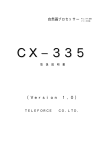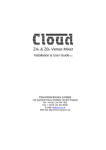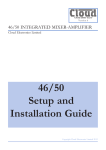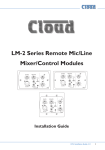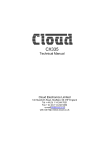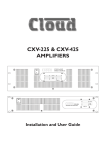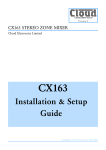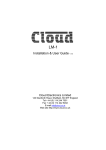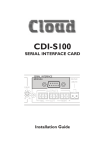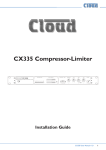Download Cloud CX335 Specifications
Transcript
CX335 Installation and Operation Manual V3.0 Cloud Electronics Limited 140 Staniforth Road, Sheffield, S9 3HF England Tel + 44 (0) 114 244 7051 Fax + 44 (0) 114 242 5462 E-mail [email protected] Web site http://www.cloud.co.uk CX335: Installation and Operation Manual Page 1 CX335 STEREO COMPRESSOR LIMITER Installation and Operation Manual CONTENTS Section 1 Safety Notes .....................................................................................3 2 ‘Quick Start’ ......................................................................................3 2a Soft Knee, Normal Envelope ..........................................................3 2b Hard Knee, Normal Envelope ........................................................4 2c Intelligent Limiting .........................................................................5 2d Soft Knee, Slow Envelope .............................................................5 2e Hard Knee, Slow Envelope ............................................................6 3 Introduction ......................................................................................6 4 Installation ........................................................................................7 4a Mounting......................................................................................7 4b Audio connections ........................................................................7 4c Power connections .......................................................................7 5 Compressors and Limiters Explained ...............................................8 5a What is a Compressor / Limiter? ....................................................8 5b Threshold Explained .....................................................................8 5c What is Hard-Knee and Soft-Knee? ...............................................9 5d Ratio Explained ............................................................................9 5e What about Attack and Release Controls? ......................................9 5f Gain Requirements.....................................................................10 5g Understanding Compressor/Limiters Verses Peak Limiting .............10 5h Other Nomenclature ...................................................................10 6 15-07-02 V3 Page Control Descriptions .......................................................................10 6a Envelope Switch .........................................................................10 6b Knee Switch ...............................................................................11 6c Threshold ..................................................................................11 6d Ratio .................................................................................................. 11 6e Gain ..........................................................................................11 6f Peak .................................................................................................. 11 6g Bypass Switch ................................................................................... 11 Page 2 CX335: Installation and Operation Manual CONTENTS (Cont..) Section 15-07-02 V3 Page 6h Gain Reduction Meter .................................................................12 6i Output Level Meter Displays ........................................................12 7 Operation ........................................................................................12 8 Technical Specification ...................................................................13 9 General Specification ......................................................................13 CX335: Installation and Operation Manual 1 Page 3 Safety Notes • Do not expose the unit to water or moisture • Do not expose the unit to naked flames. • Do not block or restrict any air vent • Do not operate the unit in ambient temperatures above 35oC • Do not perform any internal adjustments unless you are qualified to do so and fully understand the hazards associated with mains operated equipment. • The unit has no user serviceable parts. Refer any servicing to qualified service personnel. • If the moulded plug is cut off the lead for any reason, the discarded plug is a potential hazard and should be disposed of in a responsible manner. For more detailed information refer to the rear of the manual. 2 Quick Start 1. Connect the unit into the signal path directly after the system mixing desk or DJ console, and just before any amplifiers or crossover. 2. If your system runs balanced then used balanced XLR leads, with the standard configuration of: Pin 2 hot (positive phase); Pin 3 cold (negative phase); Pin 1 ground (screen). 3. If you are configured 'unbalanced' then we suggest that the inputs only are wired Pin 2 hot, with Pin 3 shorted to Pin 1. Do this, even if you are in a hurry. 4. If you are running a mono system you will have to connect the input signal to both channels using some form of 'Y' lead. We have carefully optimised the front panel removing most of the traditional compressor limiter controls by making the circuitry 'Programme Dependant'. To aid setting up the front panel controls the common permutations of switches and controls can be placed into four different groups, each one having different audio results. Soft Knee, Fast Time Constant (Normal Envelope) (2a): Ultra transparent Control of Sound Pressure Level (SPL) and speaker protection. Soft Knee, Slow Time Constant (Slow Envelope) (2d): Very transparent control of SPL with more peaks allowed through unprocessed. Hard Knee, Fast Time Constant (Normal Envelope) (2b): Precise control of signal level and speaker protection. Hard Knee, Slow Time Constant (Slow Envelope) (2e): The least transparent mode of operation to reduce high level signals but with more peaks passed unprocessed. 2a 15-07-02 V3 Soft Knee, Fast Time Constant (Normal Envelope) Page 4 CX335: Installation and Operation Manual This is the recommended mode of operation, yielding the most musical results with the least perceptible manipulation of the audio signal. Release both the envelope and knee switches. Set the threshold to somewhere between 10dB and 15dB LOWER than your average input level and set the ratio control somewhere between 5:1 and 10:1, if you require compression of the audio signal, but 20:1 or higher if you require compression and limiting. With normal programme level running through the CX335, rotate the gain control so that the output level on the left and right channel VU meters measures about the same in bypass mode as it does with the compressor operational. With this configuration, the louder the input then the more compression will take place. A distinguishable increase in average overall volume should be noted, although the peak output level should be slightly lower. The ‘Peak’ control operates independently from the compressor/limiter section of the CX335. It has the advantage of allowing the user to directly set an absolute limit on the maximum output level, however it has the disadvantage of not sounding as transparent as the compressor. The compressor should be set to provide most of the gain reduction. The peak limiter should be used as a safety net to protect the system when it is under abuse. The peak control is best adjusted by using the highest anticipated input level and observing the clip or peak indicators of the systems power amplifiers. The ‘Peak’ control should be set to prevent any potentially damaging amount of clipping. Note that sometimes, on systems with an active crossover, some clipping on the bass amplifiers may be acceptable. If the peak LED on the CX335 is operating more than occasionally then the unit is not adjusted for optimum performance and the compressor controls should be adjusted to give more gain reduction. 2b Hard Knee, Fast Time Constant (Normal Envelope) This mode of operation will be slightly more noticeable (especially with high ratio settings) as the point where compression takes effect is at a definite audio level. Depress the knee switch and release the envelope switch. Set the threshold to somewhere between 0dB and 8dB LOWER than your maximum input level. Set the ratio control at about 5:1 or even higher, if you require compression of the audio signal, but 20:1 or higher if you require compression and limiting. The higher the ratio the more audible the compression. Turn the gain control so that the output level on each VU meter reads about the same in bypass mode as it does with the compressor operational. Information on configuring the peak control is described in detail in section 2a, page 4. (above). With this configuration, quieter signals should pass through the compressor unprocessed, (no gain reduction taking place) but louder input signals above the threshold level will have a significant amount of compression (L.E.D’S will light on the gain reduction meter). The peak limit LED will flicker ON more often than would normally be expected, especially with very percussive tracks at high level. No perceived effect will be noticed until very high input levels are used, then the CX335 will take control to preserve system integrity. 15-07-02 V3 CX335: Installation and Operation Manual 2c Page 5 Intelligent Limiter Due to the programme dependant nature of the compressor section and its split frequency stereo side chain, the preferred method of limiting is to use the compressor section with a ratio of ∞ to 1. Depress the knee switch and release the envelope switch. Set the threshold to the level where limiting is to commence. Set the ratio control fully clockwise. Turn the gain control so that the output level on the VU meters measures about the same in bypass mode as it does with the compressor operational. Information on configuring the peak control is described in detail in section 2a, page 4. With this configuration, quieter signals will pass through the compressor unprocessed, (no gain reduction taking place) but louder input signals above the threshold level will have a definite maximum output level that will never be exceeded (L.E.D’S will light on the gain reduction meter). The peak Limit LED should never flicker if it is set correctly and providing that the gain control is not adjusted too high. 2d Soft Knee, Slow Time Constant (Slow Envelope) This mode of operation will still yield musical results, but will tend to allow the very quick dynamics through unprocessed. Therefore you will require more peak limiting and a high overhead in speaker power handling. Depress the envelope switch and release the knee switch. Set the threshold to somewhere between 10dB and 15dB LOWER than your average input level and set the ratio control somewhere between 5:1 and 10:1, if you require compression of the audio signal, but 20:1 or higher if you require compression and limiting. With normal programme level running through the CX335, rotate the gain control so that the output level on the left and right channel VU meters measures about the same in bypass mode as it does with the compressor operational. Information on configuring the peak control is described in detail in section 2a, page 4. With this configuration, the louder the input then the more compression will take place. A perceived increase in average overall volume should be noted, although the peak output level should be slightly lower. Some dynamics might cause other problems further down the signal path. 15-07-02 V3 Page 6 CX335: Installation and Operation Manual 2e Hard Knee, Slow Time Constant (Slow Envelope) This mode of operation will be the most noticeable (especially with high ratio settings and fast dance tracks) as the point where compression takes effect is at a definite audio level. Depress the knee and envelope switches. Set the ratio control at about 5:1 or even higher, if you require compression of the audio signal, but 20:1 or higher if you require compression and limiting. The higher the ratio the more audible the compression will be. A high ratio setting will allow the threshold control to be set to the maximum input level precisely. As the ratio is decreased the value of the threshold control should be reduced to compensate. Information on configuring the peak control is described in detail in section 2a, page 4. Turn the gain control so that the output level on the VU meters measures about the same in bypass mode as it does with the compressor operational. With this configuration, quieter signals should pass through the compressor unprocessed, (no gain reduction taking place) but louder input signals above the threshold level will have a significant amount of compression after the initial peak is passed unprocessed. PLEASE TAKE SOME TIME TO READ THE REMAINDER OF THE MANUAL 3 Introduction The Cloud CX335 Stereo Compressor Limiter has been designed to provide compression of full range music signals and also be suitable for overload protection in a wide range of applications. The unit can be applied equally to any discotheque or live installation as well as in the recording studio and mastering facility. Historically, it has often been impossible to establish what time constants are to be applied to a compressors attack and release envelope when the signal dynamics are an unknown quantity. The CX335 has intelligent 'Programme Dependant' circuitry, which makes the need for attack and release controls totally redundant. Other features include the options of hardknee or soft-knee characteristics, a fully controllable 'Instant-attack' peak limiter, accurate and informative metering, and remote control of the compressor side chain. The CX335 may be used in either balanced or unbalanced systems with no internal reconfiguring. Because the CX335 compressor offers a choice of traditional hard-knee, ratio style compression or soft-knee compression, it is equally adept at creative work and unobtrusive level control. With high ratio settings the compressor can perform the functions of an intelligent programme-dependent limiter. The control layout is simple and logical. For reasons that will become evident, the unit is graduated assuming that of a hard-knee ratio style compressor, although the preferred mode of operation is soft-knee where the transition from unity gain to gain reduction at the selected ratio is progressive and occurs over a nominal 10dB input level range. In other words, in soft-knee mode with high ratios, the unit will blend from gentle compression up to hard limiting with no additional front panel adjustment. 15-07-02 V3 CX335: Installation and Operation Manual Page 7 Soft-knee compressors are often chosen in applications that call for less conspicuous level control whereas ratio type hard knee compressors are generally considered more successful where large amounts of gain reduction are required. By offering both alternatives, the CX335 is capable of outstanding results in a very wide range of discotheque, studio and live sound situations. Compressors are often accused of dulling the sound being processed, and a little explanation is needed to understand exactly why that is. Bass frequency sounds, which contain most of the energy in a typical piece of music, cause a normal compressor to apply gain reduction. This is fine until quieter, high frequency sounds occur at the same time as that bass sound, these high frequencies will also be turned down in level simultaneously with the bass and therefore suffer as a consequence. This is why the cymbals and hi-hats in a heavily compressed track seem to dip in level whenever a loud bass drum or snare drum beat occurs. The 'intelligent' side-chain of the CX335 will attempt to overcome this by sensing the input frequency of the signal and adjusting itself accordingly. Another feature of the CX335 is a highly effective peak limiter that allows the user to set an absolute output level that can never be exceeded. This facility is extremely valuable for speaker driver protection. With correct threshold and ratio adjustments the compressor section can be set to act as a primary level controller with the peak limiter set above this to perform secondary security. 4 Installation 4a Mounting The CX335 is designed for standard 19" rack mounting and occupies 1U of rack space. Avoid mounting the unit directly above power amplifiers or power supplies that radiate significant amounts of heat and strong magnetic fields. Fibre or plastic washers may be used to prevent the front panel becoming marked by the mounting bolts. 4b Audio Connections The input 3pin XLR connectors may be used either balanced or unbalanced, the wiring convention being: pin 2 hot, pin 3 cold and pin 1 ground. For use with unbalanced systems, unbalancing can be achieved by shorting pin 3 of the XLR connectors to ground (pin 1) at the inputs. In both modes of operation the systems input level should be referenced to 0dBu. The CX335 is designed as a stereo compressor and always expects to be used with matching left and right stereo signals. Unexpected and unusable results will occur if two independent mono signals are fed through the unit. Furthermore, if the audio system being processed is configured for mono operation you will have to connect an input signal to both channels to make any sense of the front panel meter calibration and control graticules, although only one output socket need be used. If earth loop problems are encountered, do not disconnect the mains earth but instead, operate the system in the balanced mode with the cable screen only connected at the receiving end of the cables. If the system can only be operated in the unbalanced mode, then we suggest that an audio isolating transformer be used. UNDER NO CIRCUMSTANCES MUST ANY EARTH CONNECTIONS BE REMOVED. 4c Power Connection The unit will have been configured to operate on a power input of 220 to 240 Volts AC at 40 to 60Hz. If for some reason the unit is to be used at a mains input operating voltage which is different to that as supplied, the following procedure must be carried out. (See the diagram on the following page) 15-07-02 V3 Page 8 CX335: Installation and Operation Manual VOLTS OPERATION FIT TWO LINKS FOR 110/120 TRANSFORMER 120V TRANSFORMER HIGH VOLTAGE VOLTS OPERATION HIGH VOLTAGE FIT ONE LINK FOR 220/240 240V 120V VIEW INSIDE CX335 SHOWING POSITION OF VOLTAGE SELECTION LINKS 1: Disconnect the unit from the mains. 2: Using a number 2 size pozidrive screwdriver, remove the six self-tapping screws retaining the top panel of the unit. 3: Using a number 1 size pozidrive screwdriver, remove 4 M3 machine screws that retain the main PCB to the bottom panel. These can be located: 3.1: Just behind the Threshold control 3.2: Directly behind the Gain Reduction display meter. 3.3: In front and to the rear of the grey encapsulated transformer block. 4: From the underside of the unit, remove the six self-tapping screws retaining the bottom panel of the unit, using the number 2 pozidrive. 5a: If the unit is currently configured for 220-240 Volts AC, to the side of the transformer can be found 1 zero Ohm link. This should be removed and two zero Ohm links should be fitted to the positions marked 110-120 Volts. Go to paragraph 6. 5b: If the unit is currently configured for 110-120 Volts AC, to the side of the transformer can be found 2 zero Ohm links. These should be removed and one zero Ohm link should be fitted to the position marked 220-240 Volts. 6: Replace the power fuse with a correctly rated fuse for the new operating voltage. 7: Re-fit the two covers in the reverse order. 5 Compressors and Limiters Explained 5a What is a compressor / limiter? Compression is an audio process that reduces the output progressively once the input level has risen above a pre-settable threshold. Once this threshold level is exceeded then the rate at which the output is reduced is controlled by a predictable rate, called 'ratio'. Limiting is an extension of compression where once the threshold is exceeded, the output level will not rise any further. Therefore limiting can also be perceived as a compressor with its 'ratio' set higher than 20 to 1. 5b Threshold explained As a rotary control, the threshold parameter is easy to understand. Threshold compares the input level to the level set on the front panel. It is very common to see the graticule around the threshold control marked from higher levels on the counter clockwise end to lower input levels on the clockwise end. This is because more compression happens as the control is turned 'up'. 15-07-02 V3 CX335: Installation and Operation Manual 5c Page 9 What is Hard-knee and Soft-knee? The actual threshold point where compression takes place is called the 'knee', the reason being that if a graphical representation of input level verses output level is made, then below threshold the line will be at 45° (output is the same as input). Above threshold this line will have a gentler slope equal to the ratio setting. So the line will have a definite 'fold' or 'knee'. (See diagram below). With high ratio settings this knee can be very noticeable. To prevent this sudden change between no compression below threshold and lots of compression above threshold, it is much gentler on the ear if this knee is 'rounded' or softened. Soft-knee is more musical and desirable if the actual compression process is not to be too obtrusive. So by default, the CX335 compressor limiter is a 'soft-knee' device, yet still can be overridden by use of the hard switch. Graphical Representation of Compression and Limiting INPUT IN dBs GRAPH OF INPUT LEVEL VERSES OUTPUT LEVEL NO COMPESSION +10 +5 HARD KNEE 0dB RATIO 10:1 OR LESS -5 -10 SOFT KNEE THRESHOLD LIMITING -15 RATIO 20:1 OR GREATER -20 -25 -30 OUTPUT IN dBs -30 5d -25 -20 -15 -10 -5 0dB +5 +10 Ratio explained. For a hard-knee compressor, the effect of Ratio can be easily understood by remembering that ratio is a comparison between input levels and output levels. For instance; a ratio setting of 3:1 results in only 1dB of change at the output for every rise in input level by 3dB providing that the input is greater than the threshold setting. A simple rule of reading Ratio settings can be input:output, or input rise of xdB gives output rise of ydB. For a soft-knee compressor, the Ratio control becomes a little less well defined Soft-knee gradually changes the ratio as the signal rises above the threshold setting. On the CX335 this change takes place for as much as 10dBs, so the selected ratio is only reached once the signal is 10dB above the threshold setting. This changing ratio is far more musical and disguises the fact that any manipulation of the dynamic range is taking place. 5e What about Attack and Release controls? The rate at which the compressor takes effect (once the threshold is exceeded) is called Attack, similarly the rate at which the compressor subsides (after the input signal falls below threshold) is called Release. The wrong attack time for a compressor will have different poor results for differing input frequencies. For instance too fast an attack time with low frequencies will cause distortion as the gain reduction changes during one cycle. On the contrary, too slow an attack time on high frequencies will not process the signal peaks quick enough, resulting in the possibility of system clipping and lack of speaker protection. The conclusion is that for broadband music programme a fixed attack time is virtually useless. Similarly a release control that doesn't track the input programme envelope will result in audible 'pumping' or breathing as the gain reduction changes. The CX335 gets over this problem by constantly adjusting these two crucial 'parameters' internally depending on 15-07-02 V3 Page 10 CX335: Installation and Operation Manual the level and frequency of the incoming signal. For this reason the Attack and Release controls have been removed from the front panel. 5f Gain requirements When the signal exceeds threshold and the compressor takes effect, there will be a reduction in the real output 'volume'. This volume reduction is made back up to the original level with the Gain control. In normal use, the average amount of level reduction shown on the gain reduction meter, will be the position to where the Gain control is rotated positively. A point to note is that this gain is applied to all signals, whether above or below any thresholds, so quiet sounds will be louder by the amount of gain make-up, even the residual background system noise! 5g Understanding Compressor Limiters verses Peak limiting Due to the range of the ratio control, the compressor can be set up to perform as a very effective limiter. Further more, with its soft knee operation, the characteristics of the unit blend from gentle compression for signal just above threshold, through to hard limiting. The intelligent control circuitry and programme dependent attack and release make the audible effect almost un-noticeable. This compressor limiter section should not be confused with the Peak limiter in the CX335. This is intended to be used as a system failsafe for any high peaks that are still quite high even after some compression has occurred. For example, with signals above the compressor threshold, if the ratio is set to 3:1 and the input rises by +15dB there will still be a +5dB rise at the output. This rise might cause a system overload, except this can be trapped by the Limiter section providing the Peak Limit threshold is correctly adjusted. The optimum use of the Peak Limiter is when used in this method. It is difficult to give a generalisation for limiter threshold settings as many factors govern this value: Firstly, how much level can be sent from the mixing console? In a well configured system this will average around 0dB, but with only slightly too much gain at each mixing stage this level can soon rise far higher. The Peak limiter can be set to capture this overload. Secondly, how much signal is required by the amplifier or crossover inputs? If the Peak Limiter is set too high then any peaks allowed through the CX335 might cause input distortion or overload to the following amplifier. It is more likely that the amplifiers will clip before the output signal clips 5h Other nomenclature. Side-Chain - The control circuit that decides how much gain reduction to apply at any one instant, depending on the input level and the front panel controls is called the side-chain. In a standard compressor the circuitry only has two main sections: the audio path and the side chain. Gain Reduction - The difference between the measured output level after the compressor has taken effect and the level that would be output if no processing were happening. 6 Control Descriptions 6a Envelope switch In the slow position it modifies the programme-dependant circuitry to allow fast dynamic peaks through unprocessed, yet still monitor and control level when the input is above the 15-07-02 V3 CX335: Installation and Operation Manual Page 11 threshold for periods of a second or more. If this switch is depressed it is strongly advised that the peak limiter should be used as an additional tool to restrain very loud and quick dynamic peaks. 6b Knee switch In the hard position it modifies the knee of the compressor by affecting the ratio control so that gain reduction takes place linearly once the threshold level is exceeded. It is strongly advised that the unit be configured in its intended mode of soft-knee for a more transparent compression. 6c Threshold This control determines the input level above which gain reduction will be applied and may be set in the range +10dB to -20dB. This control graticule is accurate for compression with the knee switch depressed. In the soft-knee mode, compression takes place gradually once the threshold is just exceeded. The amount of compression rises, until the input signal reaches approximately 10dB above the threshold setting, where upon conventional compression is applied at the amount dictated by the ratio control. 6d Ratio With the knee switch depressed, this control governs by how much the input level must rise before a rise of 1dB would be seen at the output. For example, (In hard-knee mode) with the input signal level above the threshold setting, a ratio setting of 5:1 would imply that the output would only rise by 1dB with a 5dB rise in the input level. With the compressor set for soft-knee, ratio fixes the final compression ratio that will be applied once the 10dB soft-knee region is exceeded. The ratio may be continuously adjusted from 1.2:1 to ∞: 1 allowing the possibility of true hard limiting. 6e Gain The output level may be attenuated or amplified by up to 12dB to compensate for level changes caused by compression and limiting. Quite often compressors are perceived to 'reduce' the total output level, this control should normally be adjusted so that the output level measures identical levels on the VU meters with bypass depressed and released. The gain control can also be set audibly if the system speakers are within unobstructed earshot. Normally this control will be operated rotated to the positive (clockwise) gain side. This control comes before the peak limiter detector and this fact should be taken into account when setting the peak limiter threshold. 6f Peak Limit Sets an absolute limit to the level that the output signal will not be permitted to exceed. The control ranges from +26dBu (where the limiter has no effect) down to -6dBu. This limiter is very fast acting enabling it to control any peaks without audible distortion. If the output signal is so high as to cause the limiter to operate for more than 20mS, the system gain is automatically reduced to bring the signal back within range. The system gain is then returned to normal over a period of approximately one-second. The peak limit control and the compressor gain control should be used in conjunction to ensure that the peak limiter operates only rarely (if at all), if it is to be used purely for peak protection. 6g Bypass This switch causes a bypass of all signal processing, where the input signal is routed directly to the output socket. Normally the switch is used to compare the raw unprocessed signal against the effects of any compression and or limiting. 15-07-02 V3 Page 12 6h CX335: Installation and Operation Manual Gain Reduction Meter A nine-segment LED bar graph meter continuously monitors the gain reduction applied by the compressor and or limiter and even any remote control voltage over the range 0 to 30dB. The amount of gain reduction shown is greatly affected by all of the front panel controls. 6i Output Level Meters These are nine segment LED bar graph level meters, that monitor the level of the two output signals over the range -20dB to +12dB with reference to the 0dBu operating level. With average stereo programme these will track together. Vastly differing levels will most likely be a cable short or external system configuration fault. 7 Operation The unit should be connected in line with the stereo signals to be processed either by breaking the existing connection between mixer console and cross-over or amplifiers or via suitable insert points on the master outputs of the console (if such exist). Setting up the front panel controls is easiest if the peak limiter threshold is initially set to maximum. This allows the compressor to be set up in isolation. The ratio setting depends on how firmly the signal dynamics need controlling; commonly, higher ratios provide a higher degree of control but also tend to be more audible in operation when high levels of gain reduction are required. The integral soft-knee feature of the CX335 renders these effects far less pronounced, but this factor should still be taken into consideration when setting up. Although, with the CX335 a higher compression ratio may be used than that of conventional compressors without compromising the sound quality. Adjust the threshold control until the desired amount of gain reduction occurs. This is judged partly by ear and partly by observing the gain reduction meter. In general, a maximum gain reduction of between 6dB and 10dB will be adequate. When in the soft knee mode, you will notice that the threshold control is rotated clockwise more than would normally be expected. Set the gain control to give the required output level using the level meter to guide you. Additional assistance can be obtained by toggling between bypass mode and normal compressor operation, in both modes the optimum gain setting will give equal output levels on the meter, but a slight increase in the 'music power' with the compressor operating. Avoid running at very high output levels as this reduces the available amount of signal headroom and could lead to distortion in extreme cases. Once the gain is correct, set the peak limiter level control so that the limiter LED only lights briefly on extreme signal peaks. Alternatively, set the peak limiter level to the desired maximum output value and then adjust the compressor gain control to ensure minimum limiter activity. One major use of the peak limit control is to prevent input distortion or clipping on the following amplifiers. If only peak limiting is required then we suggest setting the compressor ratio to greater than 1:20, the compressor threshold to at least 12dB lower than the normal input level and using the soft-knee mode as opposed to using the peak limiter alone. The peak limiter has no separate on / off control, but turning the peak Level control fully clockwise will prevent any unwanted limiter action. To effectively bypass the compressor section turn the compressor threshold up to its maximum of +10dB (fully counter-clockwise) 15-07-02 V3 CX335: Installation and Operation Manual Page 13 and set the ratio to its lowest setting of 1.2:1 although we do not recommend using the peak limiter without the support of the compressor section. 8 Technical Specifications 10kΩ INPUT IMPEDANCE +26dBu MAXIMUM INPUT LEVEL 80 Ω OUTPUT IMPEDANCE +26dBu MAXIMUM OUTPUT LEVEL 600Ω MINIMUM OUTPUT LOAD 20Hz to 20kHz ±0.5dB FREQUENCY RESPONSE <-70dB 10kHz CROSSTALK (All measurements referenced to 0dBu operating level) NOISE AT UNITY GAIN -90dB -90dB -92dB 22Hz - 22KHz CCIR ARM IEC A DISTORTION (THD and NOISE) Unity Gain, 0dBu +10dBu input 10db Gain Red 9 100Hz <0.03% <0.1% 1KHz <0.02% <0.1% 10KHz <0.03% <0.1% General Specifications POWER REQUIREMENTS FUSE RATING FUSE TYPE CASE SIZE WEIGHT 110-120 Volt or 220-240 Volt at 40-60Hz, 15 Watts 100mA for 220-240 Volts, 200mA for 120 Volts 20mm x 5mm, Class 3 type 'T' (time delay), 250 Volts working 482mm (w) x 44mm (h) x 155mm (d) 3.4 kg’s (including packaging) This product conforms to the following European EMC Standards: BS EN 55103-1:1997 BS EN 55103-2:1997 This product has been tested for use in commercial and light industrial environments. If the equipment is used in controlled EMC environments, the urban outdoors, heavy industrial environments or close to railways, transmitters, overhead power lines etc. the performance of the unit may be degraded. The product conforms to the following European electrical safety standard. BS EN 60065:1998 Safety Considerations and Information The unit must be earthed. Ensure that the mains power supply provides an effective earth connection using a three-wire termination. When the mains switch is in the off ‘O’ position the live and neutral conductors of the mains transformer are disconnected. CAUTION – Installation Do not expose the unit to water or moisture Do not expose the unit to naked flames. Do not block or restrict any air vent Do not operate the unit in ambient temperatures above 35oC 15-07-02 V3 Page 14 CX335: Installation and Operation Manual CAUTION - Mains Fuse Replace the mains fuse only with the same type and rating as marked on the rear panel. The fuse body size is 20mm x 5mm. CAUTION – Servicing The unit contains no user serviceable parts. Refer servicing to qualified service personnel. Do not perform servicing unless you are qualified to do so. Disconnect the power cable from the unit before removing the top panel and do not make any internal adjustments with the unit switched on. Only reassemble the unit using bolts/screws identical to the original parts. In the interest of continuing improvements Cloud Electronics Limited reserves the right to alter specifications without prior notice. Cloud Electronics Limited 140 Staniforth Road Sheffield S9 3HF England Telephone +44 (0) 114 244 7051 Fax +44 (0) 114 242 5462 E-mail: [email protected] 15-07-02 V3















